
Pitch Blog - What Does The Pitch Preparation Fund Cover?
To celebrate the launch of the new Pitch Preparation Fund we have teamed up with Kent FA’s Support Pitch Advisor and Groundsman of the Year, Scott Byers to give you a greater understanding of the work that the fund covers.
Clubs and organisations can apply for the grant by clicking here
Hello to you all, firstly I hope everyone is safe and following government guidelines during the Covid-19 pandemic. It has been an incredibly challenging time for all of us and hopefully soon we will get a bit of normality back.
For us groundsmen, the grass does not stop growing, does it? May is usually the time of year where clubs are carrying out renovations trying to restore their pitches for the following season.
Unfortunately, this year is very different and many pitches will be suffering with a severe lack of maintenance. However, here is some information about some of the things which you could use the Pitch Preparation Funding for:
Aeration
Aeration is an important part of any groundsman’s maintenance schedule. Grassroots pitches are being played on during all weathers with limited resources and often fall victim to waterlogging which leads to postponements. Details of the most common and effective form of decompaction are below:
Verti draining
This machine pumps holes all over the pitch and helps to relieve compaction, allows air to the roots and aids root development. This should be carried out to reduce waterlogging and improve the overall playability of your playing surface. This operation can be carried out as part of a renovation or throughout the autumn and winter months.
Depending on the scale of compaction your pitch is suffering from, verti draining can be carried out 3-4 times a year. Shockwaving is another effective form of decompaction, but this needs to be carried out well before spring to avoid surface cracking.
Top dressing (sand material)
This material will often be required during the off-season to complete a full pitch renovation. It will also be used during the season to carry out spot repairs to the surface. Top dressing helps to maintain surface levels and provides a more even surface for the players. 70/30, 80/20 and 50/50 (sand to soil) mixes are commonly used for the maintenance and upkeep of football pitches. A minimum of 40 tonnes should be applied - however, this can vary depending on the condition of your pitch. We are lucky in Kent to have a few suppliers of these materials so shop around and find the right material suitable for your playing surface.
Fertilisers
A consistent fertilising program is extremely important for your playing surfaces as it will provide your pitches with the required nutrients throughout the year. Encouraging root development, top growth, enhancing colour and helping your turf become more tolerant will result in an overall better playing surface. Fertilising programmes can vary depending on the budget available to you.
Something I have noticed on many occasions is the amount of clubs who pay for one liquid feed each year. Although these intentions are good, a liquid feed is not likely to last more than 4-6 weeks. A granular feed however, can last between 8-12 weeks, especially if a slow-release fertiliser is applied. Shop around, speak to local suppliers and gather as much information as possible. Some companies will even offer free soil testing so your fertilising program can be based on your plant’s requirements.
Grass seed
Football pitches should consist mainly of rye grass, a tolerant grass which is capable of withstanding heavy play particularly during the winter months. This seed is sold by many suppliers and prices can vary from £70 -£120 per bag. Approach suppliers for advice before selecting the seed most suitable for you.
Flail mowing
Flail mowing is often used for more of a rough cut. Areas which have become overgrown may require a flail mower. These machines are far more robust and capable than a common ride on mower or lawn mower. This operation can be carried out initially, in preparation to recover the surface for play. Ideally though, flail mowing will not be required on a football pitch unless, similar to our current situation, the pitch has not been mowed for a significant amount of time due to unforeseen circumstances.
Grass cutting
Grass cutting is the most common task for anyone responsible for maintaining a playing surface. This should be carried out a minimum of once per week at grassroots level with the cutting height being around 30mm. This h.o.c (height of cut) will provide the grass plant with the maximum protection during excessive use which most of us grassroots groundsman experience throughout the season. During the summer months this can be reduced to around 25mm although anything shorter than this could leave the playing surface open to further damage.
Ensuring that your cylinder or rotary mowers are adjusted correctly, greased and the blades are sharpened etc, will help to provide a clean and consistent finish to the playing surface. Ideally, the machine will be serviced a minimum of once per year in order for it to perform to its maximum.
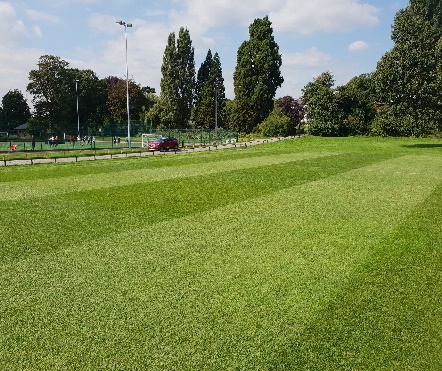
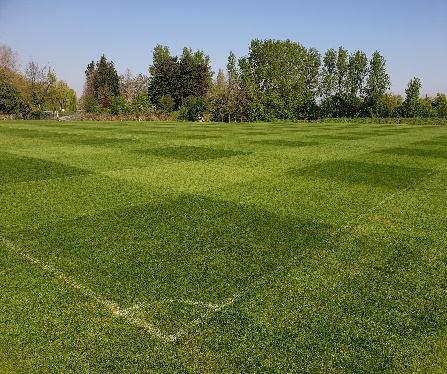
Line marking
I always view line marking as the finishing touch to a pitch. A well maintained pitch deserves a clear, visible and presentable finish with a good line marking paint.
The pitch should be marked prior to each match to ensure all lines are perfectly visible and presentable for all users. Great care must be taken to ensure all markings are straight and accurate. At K Sports, we ensure all our natural turf pitches are relined (using a string line) at least once a month to ensure they are always straight and presentable. This will also make it easier for the person over-marking the following week.
A durable, cost-effective paint and line marking machine should be used to produce the best possible pitch markings in line with your budget. This is an incredibly competitive market and prices vary considerably, so shop around and take advantage of the many free demo’s which are on offer with numerous suppliers within the sports turf industry.
Over seeding
Over seeding is a method often used in bare areas across football pitches to improve grass coverage. Over seeding can be applied in multiple ways and will usually be carried out as part of an end-of-season renovation. This can be done by using a simple disc spreader or by drilling the seed into the surface, which is often the preferred option.
Turfing
Turfing is often used as the ‘quicker’ option when carrying out repairs, particularly to goal mouths and high-wear areas. Unfortunately, turfing is not always the answer. Although turf can be laid quickly once the ground underneath is prepared, it still needs significant time to sow. On many occasions, I have seen clubs attempting to turf goal mouths during the playing season as part of a ‘quick fix’ and unfortunately (due to heavy play) the turf is pulling back up.
Similar to top-dressing and over seeding, the turf needs time. The roots must be suitably developed and capable of withstanding heavy play before the goal mouths are back in use. Regular watering will be required to ensure the plant can sow within a reasonable time.
Irrigation and weather conditions should be carefully considered before turfing operations commence.
Weed management
This is a difficult and sometimes expensive problem which many grassroots groundsmen will face. The most straightforward way to approach this is to pay a professional licensed contractor to spray a selective herbicide to your pitches. This will help to clear and prevent further weed development in your playing surfaces. However, any chemical applications should be last resort and considered carefully. In many cases, weeds can be cut or dug out from the root which avoids the need for any chemical applications which may harm the environment. Ideally though, our sports pitches should consist of desirable grasses with minimal weed coverage if they are maintained to high standards.
If your pitch is dominated with weeds, this operation should be carried out as part of a renovation. This will help to ensure the weeds you have treated are not leaving bare areas across the pitch and can be over seeded and top dressed where necessary. At K Sports, we normally apply a selective herbicide once a year, usually around mid-June.
Please stay safe and continue to follow government guidelines.
I wish you all the best with the maintenance of your pitches.
Scott Byers, Head Groundsman at K Sports.


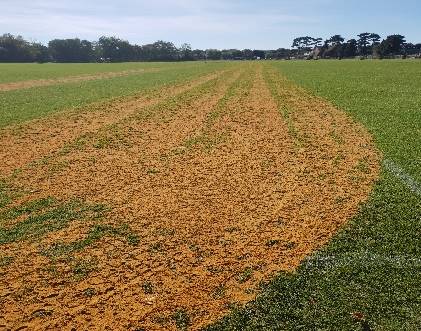
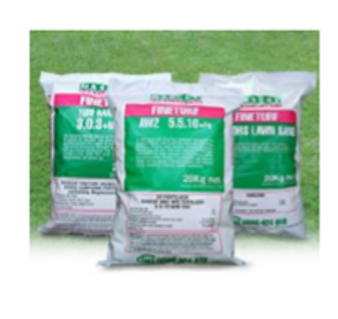
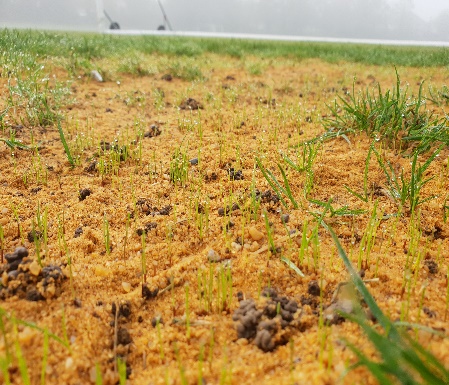
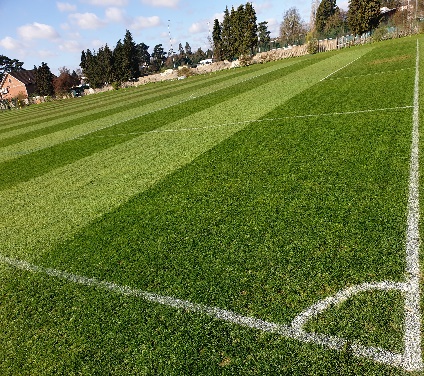
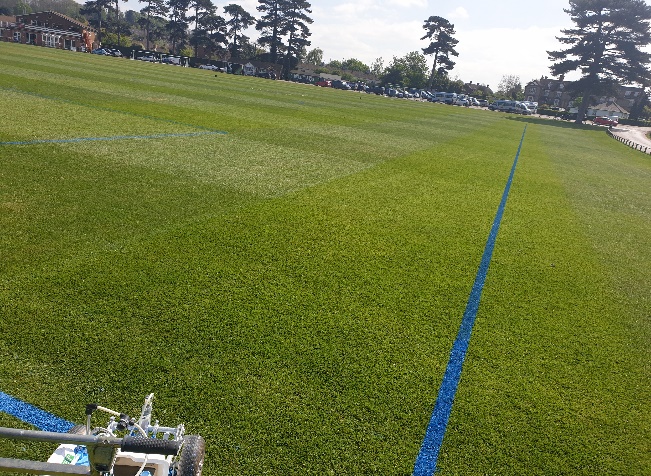

.ashx?mw=320)
.ashx?mw=320)




.ashx?mw=320)